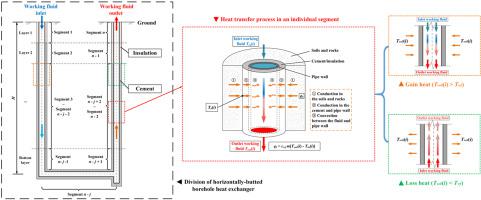Renewable Energy ( IF 8.7 ) Pub Date : 2021-02-24 , DOI: 10.1016/j.renene.2021.02.129 G.S. Jia , Z.D. Ma , Z.H. Xia , J.W. Wang , Y.P. Zhang , L.W. Jin

|
The horizontally-butted borehole heat exchanger (BHE) can be used to extract heat efficiently from medium-deep strata, where the groundwater seepage and undisturbed geothermal gradient are critical influence factors. In the application, it is an important and fundamental work to predict the BHE performance for high efficiency geothermal energy utilization. In order to solve its outlet temperature and heat exchange rate, this study develops a semi-analytical solution based on an adjustable multi-layer model associated with the moving finite line source (MFLS) method. The predicted results of a 2505 m horizontally-butted BHE show that the insulation layer and groundwater seepage are beneficial to a better performance. When the insulation depth increases from 0 to 900 m, the outlet temperature can be elevated from 40.5 °C to 48.7 °C, with the fluid volumetric flow rate given at 15 m3·h-1. With a 240 m thick aquifer layer, the groundwater seepage leads to 0.34 °C and 5.73 kW improvements in the outlet temperature and heat exchange rate, respectively. The proposed method successfully solves the problem of predicting the large depth horizontally-butted BHE drilled through various geological formations and aquifers. It can serve as a reference for the rational design of BHE systems for utilizing effectively the geothermal energy.
中文翻译:

基于地下水渗流和地热梯度的半解析法研究水平对接换热器
水平对接钻孔换热器(BHE)可用于从中等深度地层有效地吸收热量,在这种情况下,地下水的渗流和不受干扰的地热梯度是关键的影响因素。在应用中,预测高效地热能利用的BHE性能是一项重要而基础的工作。为了解决其出口温度和热交换率,本研究基于与移动有限线源(MFLS)方法相关的可调多层模型,开发了一种半解析解决方案。2505 m水平对接BHE的预测结果表明,保温层和地下水的渗入有利于提高性能。当绝缘深度从0增加到900 m时,出口温度可以从40.5°C升高到48.7°C,3 ·h -1。有了240 m厚的含水层,地下水的渗漏分别使出口温度和热交换率提高了0.34°C和5.73 kW。该方法成功地解决了预测各种地质构造和含水层中大深度水平对接BHE的问题。为有效利用地热能的BHE系统的合理设计提供参考。



























 京公网安备 11010802027423号
京公网安备 11010802027423号